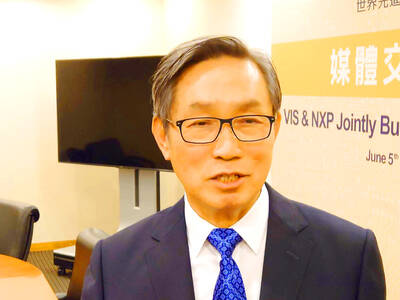Deputy Minister of Economic Affairs Tseng Wen-sheng (曾文生) yesterday agreed to reassess the metrics used in deciding the nation’s feed-in tariff (FIT) for renewable energy.
Following a heated public hearing with solar power industry representatives in Taipei, Tseng said that the Ministry of Economic Affairs (MOEA) could improve its assessment of the FIT, which it had based on a report that the Taiwan Institute of Economic Research (TIER, 台灣經濟研究院) had been commissioned to conduct at a cost of more than NT$20 million (US$649,140).
The assessment metric relies on receipts and does not fully reflect the true cost of solar projects, industry representatives said yesterday, with many tipping their hat to protesters in Paris by donning yellow reflective vests.
“Moving forward, the ministry will hold separate public hearings to iron out conflicting views on the processes for selecting solar project receipts,” Tseng told reporters on the sidelines of the hearing, following criticism that the TIER report was flawed and based on questionable data.
“Still, many are calling for a FIT cut as the cost of solar energy and its setup costs drop around the globe,” Tseng said.
Falling solar energy prices were the result of China’s so-called “May 31 New Policy,” which has exacerbated the dumping of solar modules worldwide, while prices have remained relatively unchanged in Taiwan, PV Generation System Association head Eric Kuo (郭宣甫) said.
While money could be saved by using Chinese imports, the government should support locally made products, Kuo added.
A stable FIT would help local producers weather the price slump, which should subside in the near future, Kuo said.
Separately, Star Energy Corp (星能), a subcontractor for onshore deliverables, said at a public hearing for the wind energy industry that the FIT cut had begun to cause foreign developers to consider pulling out of Taiwan.
The government’s cut is too severe and does not reflect the costs of meeting Taiwan’s higher construction expenses due to climatic and geological conditions, in addition to local content requirements, foreign wind energy developers said.
While Taiwan has proposed to cut the FIT by 12.7 percent to NT$5.106 per unit over the next 20 years, France is offering rates equivalent to between NT$5.3 and NT$7.2 without local content requirements, Wpd Taiwan Energy Co Ltd (達德能源) said.
The ministry’s plan to cap the government’s purchase of offshore wind-generated energy to 3,600 operating hours per year would also deter companies from deploying the latest turbine technology, Wpd Taiwan said, adding that a cap of 72,000 operating hours per year should be set for the next two decades.
Orsted A/S said that the rate cut, implemented at such an early stage, would prevent Taiwan’s offshore wind projects from maturing and delivering clean energy at low prices once they enter the auction bidding phase.
A period of development helped by a stable FIT is required before offshore wind energy becomes cheaper, offshore wind energy developers said.

STEEP DECLINE: Yesterday’s drop was the third-steepest in its history, the steepest being Monday’s drop in the wake of the tariff announcement on Wednesday last week Taiwanese stocks continued their heavy sell-off yesterday, as concerns over US tariffs and unwinding of leveraged bets weighed on the market. The benchmark TAIEX plunged 1,068.19 points, or 5.79 percent, to 17,391.76, notching the biggest drop among Asian peers as it hit a 15-month low. The decline came even after the government on late Tuesday authorized the NT$500 billion (US$15.2 billion) National Stabilization Fund (國安基金) to step in to buoy the market amid investors’ worries over tariffs imposed by US President Donald Trump. Yesterday’s decline was the third-steepest in its history, trailing only the declines of 2,065.87 points on Monday and

TAKING STOCK: A Taiwanese cookware firm in Vietnam urged customers to assess inventory or place orders early so shipments can reach the US while tariffs are paused Taiwanese businesses in Vietnam are exploring alternatives after the White House imposed a 46 percent import duty on Vietnamese goods, following US President Donald Trump’s announcement of “reciprocal” tariffs on the US’ trading partners. Lo Shih-liang (羅世良), chairman of Brico Industry Co (裕茂工業), a Taiwanese company that manufactures cast iron cookware and stove components in Vietnam, said that more than 40 percent of his business was tied to the US market, describing the constant US policy shifts as an emotional roller coaster. “I work during the day and stay up all night watching the news. I’ve been following US news until 3am

Six years ago, LVMH’s billionaire CEO Bernard Arnault and US President Donald Trump cut the blue ribbon on a factory in rural Texas that would make designer handbags for Louis Vuitton, one of the world’s best-known luxury brands. However, since the high-profile opening, the factory has faced a host of problems limiting production, 11 former Louis Vuitton employees said. The site has consistently ranked among the worst-performing for Louis Vuitton globally, “significantly” underperforming other facilities, said three former Louis Vuitton workers and a senior industry source, who cited internal rankings shared with staff. The plant’s problems — which have not

TARIFF CONCERNS: The chipmaker cited global uncertainty from US tariffs and a weakening economic outlook, but said its Singapore expansion remains on track Vanguard International Semiconductor Corp (世界先進), a foundry service provider specializing in producing power management and display driver chips, yesterday withdrew its full-year revenue projection of moderate growth for this year, as escalating US tariff tensions raised uncertainty and concern about a potential economic recession. The Hsinchu-based chipmaker in February said revenues this year would grow mildly from last year based on improving supply chain inventory levels and market demand. At the time, it also anticipated gradual quarter revenue growth. However, the US’ sweeping tariff policy has upended the industry’s supply chains and weakened economic prospects for the world economy, it said. “Now